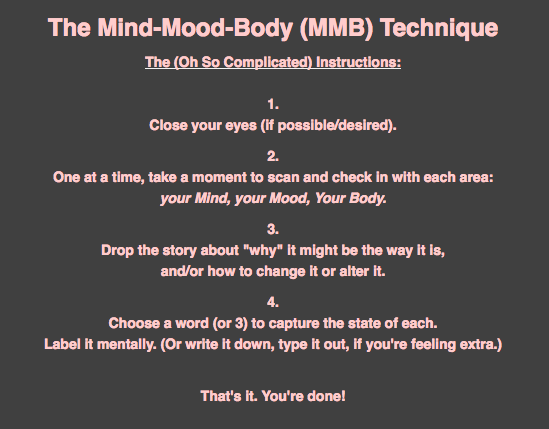Clients often show up to our sessions and groups distracted, anxious and self-judgy: still mentally in the last meeting they had, cycling through to do lists, feeling guilty that they didn’t complete every single “homework” assignment we had discussed, and judging themselves, and judging themselves some more.
Hell, when I am being coached, I sometimes show up in this distracted, anxious, perfectionist way.
Because: life of an underfulfilled overachiever.
Sound familiar?! (It’s ok, you can admit it here. There’s a whole community of us!)
Trust me when I say that nothing productive, let alone transformative, happens from this place.
So, I’ve had the unique challenge of developing a way to quickly shift her mindset, without taking up too much of our session time and also that doesn’t require extensive experience in working with one’s mind, psychology, CBT, meditation, somatic experiencing etc etc…
THUS, the Mind-Mood-Body (MMB) Technique was born.
That’s all it takes! No cushion, no fancy fingers, no lengthy time commitment, and no special conditions needed.
I start most of my sessions and groups with 30 seconds-1 minute of the MMB technique.
(Scroll down to see a more in-depth version and additional inspiration for making your MMB your own.)
It’s not just for starting coaching sessions.
This is the quickest, most powerful 30s anti-anxiety medicine and meditative mindset tool I know of…that you can use anywhere, anytime.
About to give a presentation to a room full of old white dudes? There’s a technique for that.
Trump just tweeted…and now you can’t function for the rest of the day? There’s a technique for that.
Kid just puked all over your killer OOTD as you’re walking out the door and you don’t want to lead with “my kid puked on me this morning” mood for the rest of the day? There’s a technique for that.
So, WHY exactly does it work?
The MMB Technique works in 3 ways:
1.) It gets us “present” (which is anti-anxiety medicine).
Our thinking mind is also where our stress and anxiety live. It doesn’t have the best sense of time, and often tries to address past events in the present, and also control future events in the moment. It has a wonderful tendency to keep us regretting the past (depression) and pre-regretting the future (anxiety). (I often refer to this as “future-f*cking yourself”.) Kinda overwhelming if you are trying to control all past events and all future events at once, right?! Anxiety attack central!
The thing is that our intuitive mind only exists in the present. And it is impossible to be in the past/the future AND the present at the same time.
2) It drops us into a “meditation mindset”.
It forces you to become a “witness” and an observer of yourself, which gives you some distance from the hold that our thoughts can sometimes have on us. This is what a meditation practice teaches at its core: being a conscious observer of our thoughts and ourselves. It’s a quick way to snap ourselves into “meditation mindset”: no cushion, no fancy fingers, no lengthy time commitment, and no special conditions needed.
3) It gives our brain a task (that it is actually good at).
Our logical “thinking mind” is great at many things–planning, executing, articulating, coordinating, analyzing and synthesizing–but it’s actually not great at most of the “big picture” things that really matter to us that we talk about here like purpose, fulfillment, and alignment. Plus, it always wants to get in on the action for ALL the things, way outside of what is appropriate or where it belongs. In fact, it tends to really get in the way of our “intuitive mind”, and be way louder and more obnoxious when it feels like it isn’t being paid enough attention. Basically, our “thinking mind” often has FOMO. Think of it like a squirmy little kid who wants to get in on all the “big kid” things, even when they are wholly inappropriate, and even impossible, for her. What do we do? We give her an appropriate toy that interests her, so we can continue to do our adult job, while she does her kid job.
That’s what we are doing here: we are giving the thinking mind the task of naming and labeling (this is in its wheelhouse!) what our intuitive mind is perceiving and observing.
It reminds the thinking mind and the intuitive, or perceptive, mind how they best work together and what their “right relationship” is.
Going Deeper with the MMB:
Of course, you can also linger and go deeper with the MMB technique when/if you choose. Make it yours!
Here’s some inspiration and further instruction for investigating your MMB:
Mind: Scan your mind. Assess the quality of your thoughts in this moment. What is the speed? The texture? The energy? How does your mind “feel”? Does it feel comfy to be in your mind today, or uncomfortable? Do your thoughts feel ‘hard’, or ‘soft’? ‘Calm’, or ‘agitated’, or ‘restless’, or ‘distracted’ or ‘engaged’?
Mood: Scan your mood. Notice the quality of your mood in this moment. Is your mood enjoyable and pleasant, or uncomfortable and unpleasant? What is the texture of your mood–shiny and smooth, rough and erratic, liquid and flowy? Is it dense and heavy, or light and airy? What color might your mood be? Maybe it has a shape?
Body: Scan your body. Examine the quality of your physical body in this moment. Start at the top of your head and slowly scan down your body (like one of those airport body scanners), all the way to your toes. What is the overall felt sense in your body? What is the most prevalent sensation you notice? Where is there tension? Find the part of your body that has the most ease. And the part that feels the most pleasant.
Let us know how the MMB technique works for you!!
Plus, this is an amazing in-the-moment anti-anxiety technique, but there are also techniques for de-stressing your whole life here:
https://meganhellerer.com/insights/the-life-changing-magic-of-tidying-up-your-life/


